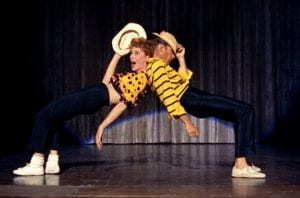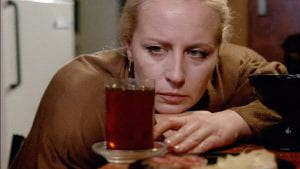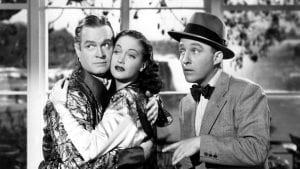Every month, A Place for Film brings you a selection of films from our group of regular bloggers. Even though these films aren’t currently being screened at the IU Cinema, this series reflects the varied programming that can be found at the Cinema and demonstrates the eclectic tastes of the bloggers. Each contributor has picked one film that they saw this month that they couldn’t wait to share with others. Keep reading to find out what discoveries these cinephiles have made, as well as some of the old friends they’ve revisited.
Jack Miller, contributor | Puissance de la Parole (1988)
Since November of last year, I’ve been trying to see every work that I can get my hands on by the great Jean-Luc Godard, a process that has proven to be extremely rewarding and energizing for me personally. A lesser-known work from Godard’s celebrated ‘return to narrative’ in the 1980s, Puissance de la parole (1988, which translates to “The Power of Speech”), is only 25 minutes long, and yet it strikes me as one of Godard’s densest and most audacious achievements. In keeping with Godard’s obsessive practice of quoting from literature and the other arts (a preoccupation that perhaps reaches its culmination in 1990 with Nouvelle Vague — a work in which every line of dialogue can be traced back to a literary source), this film dramatizes two preexisting texts: 1) “The Power of Words” by Edgar Allan Poe, a philosophical dialogue published posthumously in 1903, which relays a fictional exchange between two angels, Oinos and Agathos, and 2) dialogue from James M. Cain’s hardboiled crime novel The Postman Always Rings Twice from 1934. “What good is writing when so many things have already been written?” Luc Moullet once asked in effort to explain Godard’s quotation-practice.
The images that Godard films to accompany these texts complicate our usual understanding of literary adaptation. Cain’s novel is transposed to a modern-day setting, with a pair of separated lovers failing to communicate to one another over the telephone (the film itself was commissioned by France Telecom as an advertisement for a new line of phones — an exercise in branding that Godard hilariously refuses to deliver). These scenes alternate throughout with the Poe recitation, in which a beautiful, young woman talks through the abstract, metaphysical text with an older, male angel. Godard interrupts and disrupts both scenes constantly with shots of satellites and of the cosmos, as well as through a fragmentary soundtrack which utilizes the music of Bach, Beethoven, Leonard Cohen, John Cage, and Bob Dylan, among others.
The editing is rapid and complex, reminding us that Godard has always been more an artist of montage and impurity than one of the scenario in its pure state. Godard layers multiple superimpositions atop one another, so that we see shots of the sky and passing clouds hovering over the young angel’s face, or orgiastic shots of volcanic eruption atop a flight of Top Gun-like aircrafts. Moullet, in his wonderful essay on the film, notes that this film is both an example of “every epoque finally being brought together,” as well as a frenzied attempt to “show time,” to film “movement and immobility at once.” In a beautiful, summative moment, the young angel Oinos states that, “The source of all motion is thought.” In many ways, this is a daunting, challenging work, but it’s also a crucial and mysterious one that more than repays some concentrated effort on the part of the viewer.
There’s no trailer, but the entire film with English subtitles can be found on YouTube (warning: film does contain flashing imagery).
Jesse Pasternack, contributor | DekaDonen 2: Dekalog: Two (1988) and Damn Yankees (1958)
(Once a month, Jesse will watch a double feature he calls the DekaDonen, which consists of an episode of Krzystztof Kieslowski’s miniseries Dekalog and a film by Stanley Donen. He’ll be watching and writing about these double features until October.)
Out of all of the double features I have programmed for this series, few of them at a first glance seem to fit together as imperfectly as this one. Dekalog: Two is one of director Krzystztof Kieslowski’s more subtle and tender-hearted ethical tales. Damn Yankees is a bright and brassy musical. But they both offer different variations on the same theme: how caring for another person can transform the most uncompromising of people.
Both of these artistic works have protagonists who are trapped in a kind of stasis by circumstances beyond their control. The protagonist of Dekalog: Two is an unnamed, elderly Polish doctor who has grown cold emotionally after the death of his family in a German air raid during World War II. In Damn Yankees, the protagonist is Joe Boyd, a middle-aged baseball fan whose passion for the sport (and regret over never going pro) strains his marriage. Both men will be tested — the doctor by the warm-hearted wife of a comatose patient who faces a dilemma related to an unexpected pregnancy, and Boyd by an offer from the devilish “Mr. Applegate” to become a baseball superstar in exchange for his soul. Both protagonists will find themselves changing (in Boyd’s case literally after Mr. Applegate turns him into a younger man) as they realize what is most important in their lives.
Kieslowski and Donen differentiate their similar stories through the diverging demands of their genres. While Kieslowski would experiment with genre elements in later episodes of Dekalog (beginning as early as the next one), here he is working comfortably in the kind of individualized, mystical-tinged melodrama whose rules he would invent and perfect throughout his career. In contrast, Donen, who co-directed this film with George Abbott (the director of the original Broadway production of Damn Yankees), would have to obey the demands of the mid-twentieth-century Hollywood musical. Kieslowski could directly explore serious themes related to abortion and PTSD in Dekalog: Two, while Donen could only consider his story’s darkly satirical take on male midlife crises and sexuality as subtext in between the cheerful musical numbers expertly choreographed by a young Bob Fosse.
Nevertheless, both directors would be able to end their stories on a thematic note of transformation. The elderly doctor is able to comfort the wife of the comatose patient (even if his decision stretches an ethical boundary and doesn’t turn out how he expected), while Boyd realizes his marriage is more important than his boyhood dream. These narrative beats show that, for all of their differences, Kieslowski and Donen both knew how to end their stories on a moment of humanity.
You can view a trailer for Dekalog here.
Laura Ivins, contributor | Judy & Punch (2019)
I’m a sucker for marionettes, puppets, and dolls on film. From Brothers Quay to Chuckie, I’m in. So of course when Hulu said, “You might be interested in this,” I said, “Why, yes I am.”
Judy & Punch follows a husband-and-wife puppeteer team in a 17th-century English village. Punch (Damon Herriman) fancies himself “the greatest puppeteer of his generation,” but spends most of his time getting drunk. His wife, Judy (Mia Wasikowska), displays quite delicate puppetry skills, but is undermined by Punch’s alcoholism and violent outbursts.
The film takes two turns that are quite surprising — don’t read any online synopses or watch the trailer! This is best going in fresh! — and offers a vision of a utopian feminist co-op. Herriman plays a great self-absorbed screw-up, and of course I love Wasikowska onscreen, but the dark horse stand-out was Lucy Velik as Punch’s mistress. An Australian television actor, Velik brought wry silliness to a role that could easily have been played too broad. I appreciated Velik’s comedic timing and the innocence of her character.
This was Mirrah Foulkes’ directorial debut. I’ll be curious to see what story she tells next.
Michaela Owens, Editor | Road to Rio (1947)
With the exception of the 1962’s Road to Hong Kong, the “Road” movies starring Bob Hope, Bing Crosby, and Dorothy Lamour are some of the funniest, weirdest comedies that ever came out of classic Hollywood. Brimming over with inside jokes, fourth-wall breaking, delightful musical numbers, and plenty of decadent costumes and sets, the series always features Hope and Crosby as a pair of pals who find themselves in the worst situations as they travel to such places as Morocco, Bali, and Zanzibar. To be honest, not all of the films have aged well, but one of the best entries, I discovered this month, is Road to Rio.
From the moment the opening credits started, this movie had me hook, line, and sinker. Nothing makes me happier than when Hope and Crosby are together and that’s especially true here. I lost count of how many times their fast-flying dialogue and zany antics made me outright snort with laughter, and the addition of the very talented, very funny Wiere Brothers took things to a whole ‘nother level. Also elevating the film was the divine Ms. Lamour (of course!), Gale Sondergaard as her evil aunt, Lamour’s stunning Edith Head wardrobe, and a string of musical numbers that were so excellently staged and executed that I had to rewind and watch them a second time after the movie was over. Just writing about Road to Rio has me itching to see it again!
I couldn’t find a trailer, so instead here is a clip from the film:




